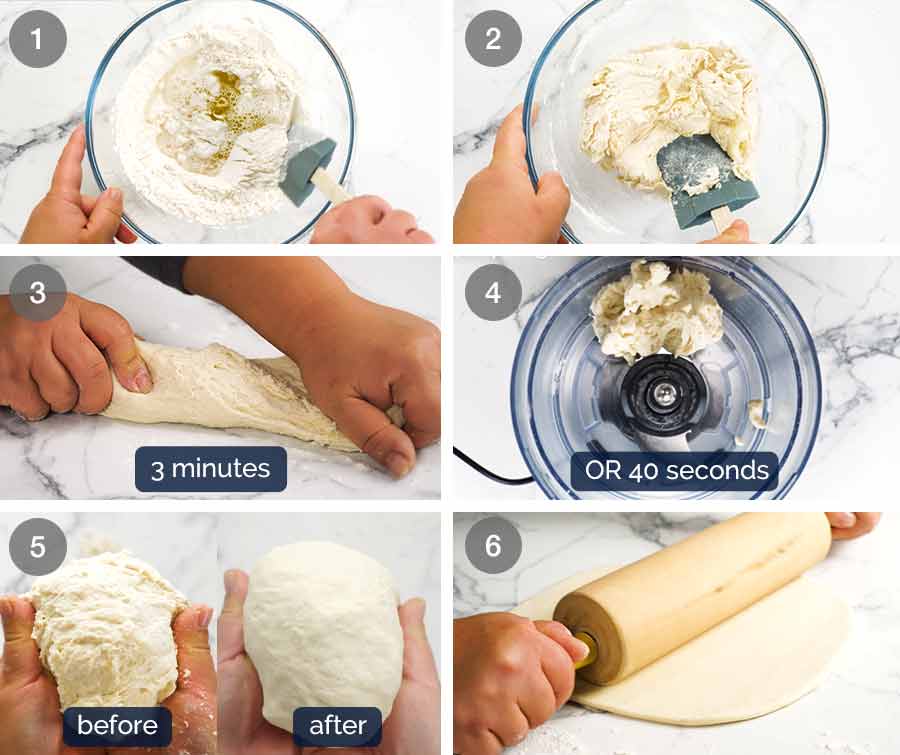Can You Make Pizza Dough Without Yeast?

Can You Make Pizza Dough Without Yeast? Yes, you can make pizza dough without yeast. Here’s a simple recipe to make yeast-free pizza dough that is just as delicious and easy to make as traditional dough.
Pizza is a beloved dish enjoyed by people all over the world. The combination of a crispy crust, tangy tomato sauce, and melty cheese is simply irresistible. However, traditional pizza dough requires yeast to rise and develop its characteristic texture.
But fear not, if you find yourself without yeast in your pantry, you can still satisfy your pizza cravings with a yeast-free alternative. In this blog post, we will explore a simple recipe to make delicious Pizza crust without yeast. Whether you have dietary restrictions, prefer a quicker preparation method, or simply run out of yeast, this recipe will come in handy. So let’s get started and learn how to make pizza dough without yeast.
The Secret To Yeast-free Pizza Dough
When it comes to making pizza dough without yeast, it’s possible to achieve a delicious result. The yeast-free dough can be a great option for individuals with dietary restrictions or those who simply prefer a different taste. By skipping the yeast, you can create a pizza crust that is denser and more bread-like in texture. The key ingredients for yeast-free dough typically include all-purpose flour, baking powder, salt, olive oil, and water. These simple components come together to form a tasty base for your favorite pizza toppings. Whether you’re looking to experiment with new recipes or need a quick and easy pizza crust, yeast-free dough is worth a try.
Exploring Alternative Leavening Agents
When it comes to making pizza dough without yeast, you can explore alternative leavening agents such as baking powder. Baking powder works wonders by providing the necessary lift and texture to the dough. It consists of a combination of baking soda, cream of tartar, and cornstarch, which creates carbon dioxide when mixed with liquid and heat. The role of baking soda is crucial in this process, as it reacts with acidic ingredients to produce carbon dioxide, resulting in a light and airy pizza crust.
Step-by-step Guide To Making Yeast-free Dough
To make yeast-free pizza dough, you will need:
| 2 cups of all-purpose flour | 1 tablespoon of baking powder |
| 1/2 teaspoon of salt | 3/4 cup of water |
| 2 tablespoons of olive oil |
Instructions:
- In a large mixing bowl, whisk together the flour, baking powder, and salt.
- Add the water and olive oil to the mixture and stir until a dough forms.
- Dust a clean surface with flour and knead the dough for about 5 minutes until it becomes smooth and elastic.
- Let the dough rest for 10 minutes before rolling it out into a pizza shape.
- Add your desired toppings and bake in a preheated oven at 425°F for 12-15 minutes.
By following these simple steps, you can make delicious pizza dough without yeast in no time!

Flavor Enhancements For Yeast-free Dough
Enhance yeast-free pizza dough by adding flavorful herbs and spices.
Infuse cheese and garlic to elevate the taste of your dough.
Rolling And Shaping Techniques
When rolling pizza dough, aim for a consistent thickness.
Use a rolling pin to achieve an even and smooth surface.
Shape the dough into a round form for a traditional pizza.
For a thin crust, roll the dough into a larger, thinner circle.
To create a thick crust, leave the edges slightly thicker.
Experiment with different shaping techniques to find your preference.
Toppings And Sauces That Complement
Enhance your yeast-free pizza dough with a medley of flavorful toppings and sauces that perfectly complement each bite. From fresh vegetables to savory meats, and zesty marinara to creamy white sauce, there are endless creative options to elevate your homemade pizza experience.
| Best Toppings for a Yeast-Free Base | Sauce Pairings |
| Mushrooms, bell peppers, onions | Tomato sauce, BBQ sauce, pesto |
| Olives, spinach, artichokes | Garlic aioli, Alfredo sauce |
Cooking Without Yeast: Oven And Alternative Methods
Pizza dough is traditionally made with yeast, but if you don’t have any on hand or want to try a different method, there are options. One method is to make a sourdough starter and use that in place of yeast. Another option is to use baking powder or baking soda as a leavening agent.
Oven Baking Tips
When baking pizza dough without yeast in the oven, preheat the oven to the highest temperature possible. Roll out the dough and add toppings, then bake for 10-12 minutes or until the crust is crispy. For a crisper crust, bake the dough on a preheated pizza stone or cast iron skillet.
Skillet And Grill Options
If you don’t have an oven or want to try something different, you can also cook pizza dough without yeast on a skillet or grill. Heat the skillet or grill on medium-high heat and add the rolled-out dough. Add toppings and cover to let the cheese melt. Cook for 5-7 minutes or until the crust is crispy.
| Ingredients for Baking Powder Pizza Dough | Ingredients for Baking Soda Pizza Dough |
|---|---|
| 1 1/2 cups flour | 1 1/2 cups flour |
| 2 teaspoons baking powder | 1 teaspoon baking soda |
| 1/2 teaspoon salt | 1/2 teaspoon salt |
| 1/2 cup water | 1/2 cup water |
| 1/4 cup olive oil | 1/4 cup olive oil |
Troubleshooting Common Yeast-free Pizza Dough Issues
Dealing with Tough Dough:
- Make sure you knead the dough thoroughly to activate the gluten and create elasticity.
- Consider adding more moisture to the dough if it feels too dry. This can be done by adding a bit of water or olive oil.
- If the dough is too tough to roll out, let it rest for 10-15 minutes before attempting to shape it.
Ensuring Even Cooking:
- Roll the dough out evenly to ensure it cooks evenly.
- Prick the dough with a fork before adding toppings to prevent air bubbles from forming and causing uneven cooking.
- Cook the pizza on a preheated baking stone or sheet pan to help evenly distribute heat.
Serving And Storage Suggestions
For those who want to make pizza dough without yeast, there are several alternatives like using baking powder, self-rising flour, or sourdough starter. However, the serving and storage suggestions may differ depending on the recipe used. It’s important to follow the instructions carefully to achieve the desired texture and flavor.
| For serving, bake the dough with preferred toppings. | Enjoy freshly made yeast-free pizza immediately. |
| To store leftover dough, wrap it tightly in plastic. | Refrigerate for up to 2 days or freeze for later use. |
Health Benefits Of Yeast-free Pizza Dough
Yeast-free pizza dough offers digestive advantages due to reduced bloating and discomfort.
It’s beneficial for those with yeast sensitivities and can aid in maintaining a healthy gut.
Moreover, it’s a great option for individuals seeking to reduce their caloric intake.
By eliminating yeast, you can create a lighter, lower-calorie pizza crust.

Frequently Asked Questions
What Happens If You Don’t Put Leaven In Pizza Dough?
Without leaven, pizza dough won’t rise, resulting in a dense, flat crust. Leaven creates an airy texture.
What Can You Use Instead Of Yeast In Pizza Dough?
You can use baking powder or self-rising flour as alternatives to yeast in pizza dough.
Does Pizza Taste Good Without Yeast?
Pizza can still taste delicious without yeast. The absence of yeast may affect the texture, but the flavors from the toppings and sauce can still make it enjoyable. Experiment with alternative dough recipes or try a thin crust style for a different experience.
Does Pizza Dough Always Have Leaven?
Not all pizza dough has leaven; some recipes use alternative leavening agents like baking powder.
Conclusion
Making pizza dough without yeast is possible and offers a quick alternative. Experimenting with different recipes can lead to delicious results. Whether using baking powder, sourdough starter, or self-rising flour, there are options to suit various preferences. Get creative in the kitchen and enjoy homemade pizza anytime.






